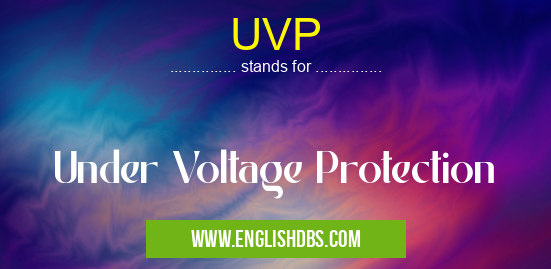What does UVP mean in UNCLASSIFIED
Protecting electrical devices from potential damage caused by low voltage is crucial in various industries and applications. UVP (Under Voltage Protection) is a prevalent and essential safety mechanism designed to safeguard electrical systems and equipment from the detrimental effects of voltage drops or outages. This article delves into the significance and implementation of UVP, providing a comprehensive understanding of its role in ensuring electrical safety.

UVP meaning in Unclassified in Miscellaneous
UVP mostly used in an acronym Unclassified in Category Miscellaneous that means Under Voltage Protection
Shorthand: UVP,
Full Form: Under Voltage Protection
For more information of "Under Voltage Protection", see the section below.
UVP Meaning
UVP stands for Under Voltage Protection, a protective measure that monitors the voltage levels in an electrical system. When the voltage drops below a predetermined threshold, the UVP system triggers an automatic response to protect the connected devices. This response can involve isolating the affected equipment, reducing the load, or shutting down the system altogether.
UVP Full Form
- U: Under
- V: Voltage
- P: Protection
How UVP Works
UVP systems employ voltage sensors to continuously monitor the voltage levels in an electrical system. These sensors are set to specific thresholds, which vary depending on the application and the equipment being protected. When the voltage falls below the predefined threshold, the UVP system activates, initiating the appropriate protective action.
Importance of UVP
UVP is essential for protecting electrical devices from damage caused by low voltage. Voltage drops or outages can lead to various issues, including:
- Equipment malfunction
- Overheating
- Reduced efficiency
- Data loss
- Fire hazards
UVP systems prevent these potential risks by detecting and responding to voltage fluctuations, safeguarding the integrity and functionality of electrical systems.
Essential Questions and Answers on Under Voltage Protection in "MISCELLANEOUS»UNFILED"
What is UVP (Under Voltage Protection)?
Under Voltage Protection (UVP) is a safety feature designed to protect electrical devices from damage caused by excessively low voltage levels. It automatically disconnects power to the device when the voltage drops below a predetermined threshold.
Why is UVP Important?
UVP is crucial for safeguarding sensitive electronic components from voltage fluctuations that can cause malfunctions, performance degradation, or even permanent damage. It ensures a stable and reliable power supply for critical equipment.
How Does UVP Work?
UVP circuits typically employ voltage sensors to monitor the incoming power supply. When the voltage drops below the set threshold, the sensor activates a switch that cuts off power to the device. The device will remain disconnected until the voltage returns to a safe level.
What are Typical Thresholds for UVP?
The UVP threshold varies depending on the device and its voltage requirements. Common thresholds range between 90-110 volts for household appliances and 200-240 volts for industrial equipment.
What Types of Devices Use UVP?
UVP is widely used in various electrical and electronic devices, including:
- Power supplies
- Computers and laptops
- Medical equipment
- Industrial machinery
- Consumer electronics
Final Words: UVP (Under Voltage Protection) is a critical safety mechanism that plays a vital role in protecting electrical devices and systems from the damaging effects of voltage drops and outages. By monitoring voltage levels and triggering appropriate responses, UVP ensures the stability, efficiency, and longevity of electrical installations. Understanding and implementing UVP is crucial for maintaining electrical safety and preventing potential hazards in various industries and applications.
